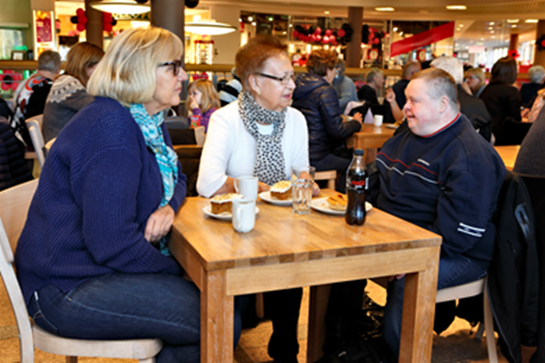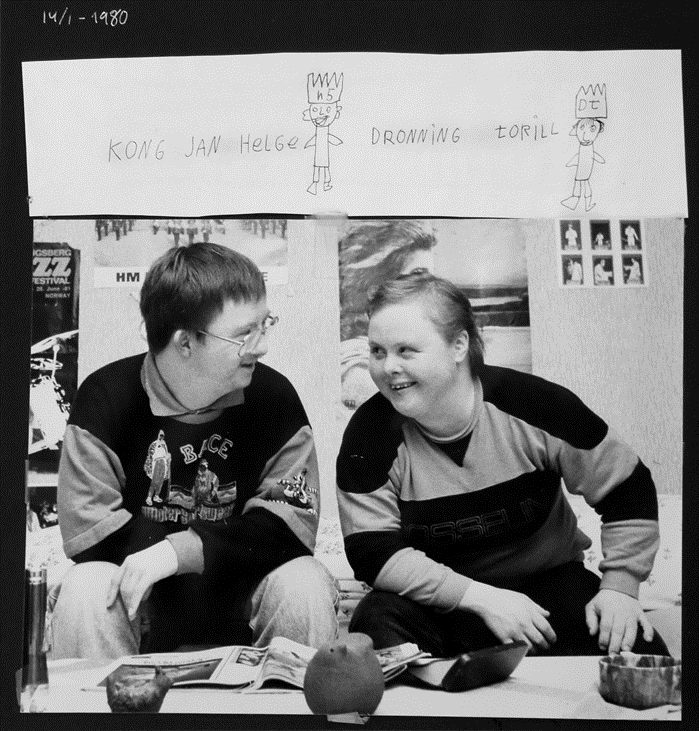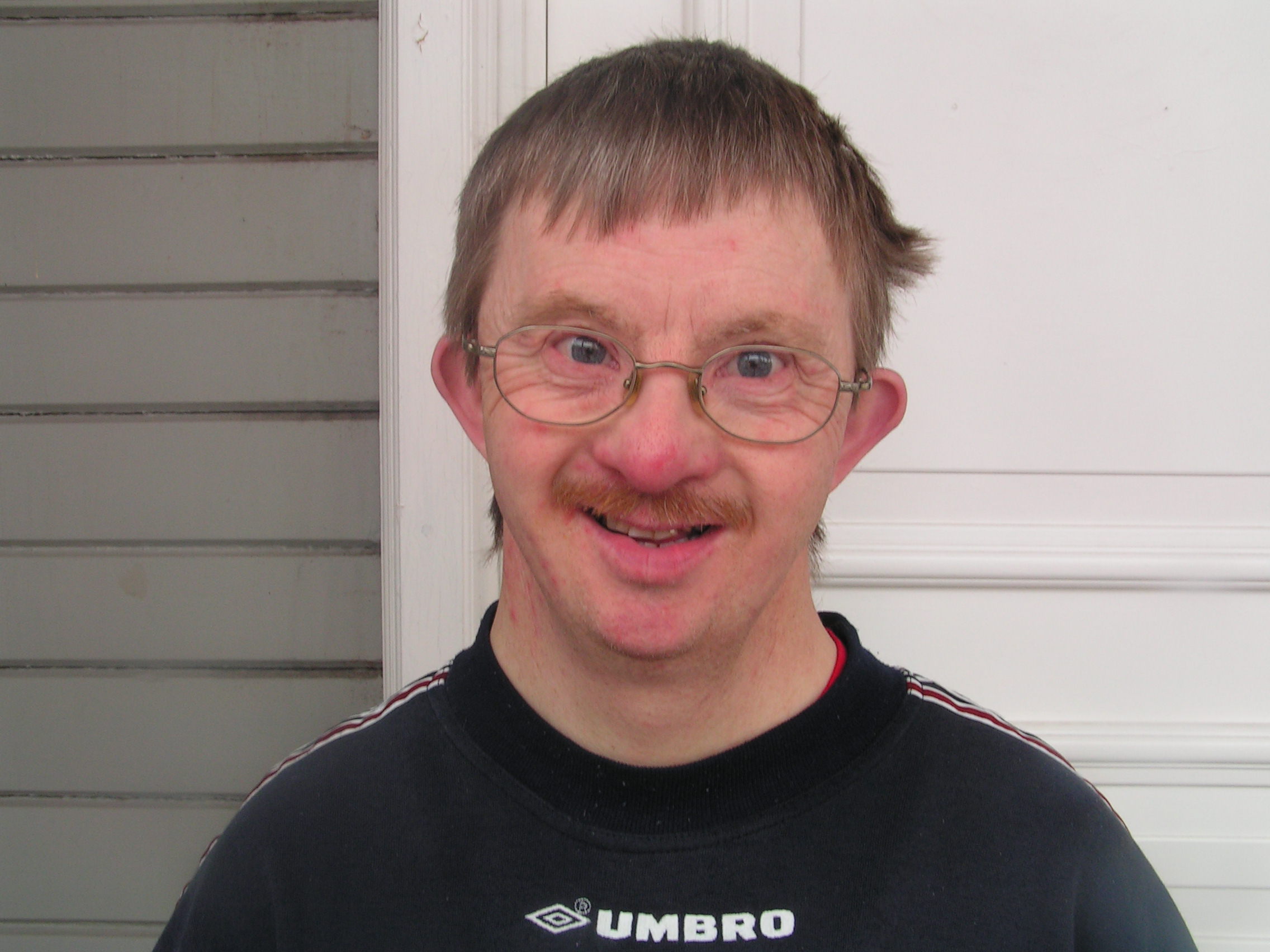Ageing
3. Friendship and socialisation
3.2. Different kind of friendship
Most important is not how many friends I have
and who they are.
Most important is that they are good with me (1:10).
Torill and I have talked a lot about the quality of a good friendship and the importance of having different kinds of friends. Torill says that good friends help her to feel free to live her life. Together we have found out that good friends are usually, someone we have known for several years, people who:
- Have tolerated and encouraged us
- We feel relaxed with
- Understand us the way we want to be understood
- We feel comfortable sharing our inner thoughts with
- Share their life with us
- We have memorable experiences with
Both of us feel more friendship with someone in our family than with others. We think there are more people who have the same experience. Perhaps we feel like that because we are more accepted and appreciated by this family member.
Torill and I have many similar thoughts about our friendship. However, there are also differences between us. Even if Torill have lived an independent life, there are people who are deciding a lot in her life. This is okay for her, most of the time; she knows there are many things she needs help to manage. The need she has influences our friendship. We always decide things together; even I must take more responsibility when we are together. Because she needs more help now when she is older, there are many activities she is not able to perform independently, but together we do everything we want!
 Photo: Britt-Evy Westergård
Photo: Britt-Evy Westergård
There is a difference between acquaintances and friends. An acquaintance is someone we may have grown up with, or someone we know from interest groups we have attended. Torill and I have attended the same sport and youth club. We know people from the same neighbourhood, which means that we have a common framework of reference when we talk about people we know. Usually Torill is the one that tells me news about our common acquaintances. This gives her an important social role in our friendship. Meeting acquaintances can become a source to have something to tell others: “Today I met ... it was nice ... do you know what he said ....”, - people who tells news, feel themselves important.
Peer support models prevalent in the general population also apply to adults with ID. Peer support efforts are social, emotional or practical help that people with ID can give to one another. Such models can facilitate understanding and provide support when, e.g. the effects of dementia are discussed, within the context of what adults with ID experience. Peer support efforts can also apply to aiding adults with ID who have become the cares for aging parents, spouses, and friends.
Torill says: "Some of my friends have disabilities, others not. I have friends in my family, neighbours and staff that help me in everyday life. I have friends from places I have worked at and schools I have attended. I have friends in football" (1:11).
Many of Torill’s friends have known her since she was in her teens. Her parents gave her confidence and freedom to go/bike around in the community. They encouraged her to keep in touch with people she liked. Eventually, the parents became so familiar with some of Torill's staff, that they spent vacations together. This period in Torill’s life, was very important and she talks about it with great pleasure. Karen Pedersen and Torill are still meeting regularly.
Torill says: "Karin Pedersen I got to know each other in 1981, I think. She is the staff I remember best from my first home… She is a lively girl. I have had good contact with her all the time. She invited me on holiday to Sørlandet the first time. Today, I have contact with Karin Pedersen when we meet at the cafe together with Karin Wessel. Karin Wessel did the washing at my former school and was one of the first staff in my housing. She has been at each of my birthdays since" (1:45).
s and friends. An acquaintance is someone we may have grown up with, or someone we know from interest groups we have attended. Torill and I have attended the same sport and youth club. We know people from the same neighborhood, which means that we have a common framework of reference when we talk about people we know. Usually Torill is the one that tells me news about our common acquaintances. This gives her an important social role in our friendship. Meeting acquaintances can become a source to have something to tell others: “Today I met ... it was nice ... do you know what he said ....”, - people who tells news, feel themselves important.Peer support models prevalent in the general population also apply to adults with ID. Peer support efforts are social, emotional or practical help that people with ID can give to one another. Such models can facilitate understanding and provide support when, e.g. the effects of dementia are discussed, within the context of what adults with ID experience. Peer support efforts can also apply to aiding adults with ID who have become the cares for aging parents, spouses, and friends.
Torill says: "Some of my friends have disabilities, others not. I have friends in my family, neighbours and staff that help me in everyday life. I have friends from places I have worked at and schools I have attended. I have friends in football" (1:11).
Many of Torill’s friends have known her since she was in her teens. Her parents gave her confidence and freedom to go/bike around in the community. They encouraged her to keep in touch with people she liked. Eventually, the parents became so familiar with some of Torill's staff, that they spent vacations together. This period in Torill’s life, was very important and she talks about it with great pleasure. Karen Pedersen and Torill are still meeting regularly.
Torill says: "Karin Pedersen I got to know each other in 1981, I think. She is the staff I remember best from my first home… She is a lively girl. I have had good contact with her all the time. She invited me on holiday to Sørlandet the first time. Today, I have contact with Karin Pedersen when we meet at the cafe together with Karin Wessel. Karin Wessel did the washing at my former school and was one of the first staff in my housing. She has been at each of my birthdays since" (1:45).
 Photo: Jørn Grønlund
Photo: Jørn Grønlund
Torill says: "The best friend, I have had for the longest time in my life, is Jan Helge. I have known him for over 40 years. He was an ordinary boy, about the same as me, with Down's syndrome … (1:36). Jan Helge was a little bit special. He was concerned that we should be fairly treated. If it did not happen, he clearly spoke up to the staff. We felt safe with each other and knew each other so well. We were so much together for many years" (1:37). 53 years old, Jan Helge died on August 14th 2011.
 Photo: private
Photo: private
 Photo: Lars A. Hynne
Photo: Lars A. Hynne
Torill says: "When I grew up, I had good friends in my neighbourhood. The best friends I had, were adults. Many were married couples (1:19). The neighbors taught me many things. At Gundersen’s I learned to play billiard, so I could play with the youngsters at the local discotheque. The youngsters thought I was good at billiard and they were happy when I won. When I won, I was gentle for the rest of that evening. When I did not win, I was a little depressed and not good to talk to (1:20). Robert and «Gundersen» (Geir Arne) are the ones I'm with when I meet other friends at sport. They are two former football players from Skrim. They take me to football and handball matches. Without them, it would have been difficult for me to see so many matches. They are awesome" (1:92).
 Photo: Jørn Grønlund
Photo: Jørn Grønlund
Torill says: "My best friend and only boy I have in my life now, is Tommy. Tommy is a cool man, gentle, nice and real. He also has Down's syndrome. I like that so much. Jan Helge and Tommy are the best friends I have had in my life. Jan Helge was more like a warrior, that is not the case with Tommy. Jan Helge enjoyed fighting, but that's not the case with Tommy. Tommy is too good, and he gets scared easily, so I have to take care of him. I comfort him…"(1:76-79).
 Photo: Jørn Grønlund
Photo: Jørn Grønlund
When Torill describes her best friend today, people ask if Tommy is her boyfriend. Her answer to that is "we are friends and nothing more". Torill and I have talked about differences between friendship and boyfriend. Our opinion is that only those who are in the relationship, are able to give a good answer to these questions. Some may say that the boundary goes between sex or not, but this is not necessarily what Torill and Tommy think. Sometimes other people care too much and adds things to peoples’ relationship that is not right. This is sometimes devastating to Torill and other people in her situation. It is important to respect the way they define their friendship.
ACTIVITIES:
- Discuss with your child/sibling/client about what friendship is, you may use some of the examples from this page.
- Talk about where they think the limits goes between a friend and a boy/girlfriend?
- Find out if some of the friends your child/sibling/client have, can make agreements on activities they can do on regular basis?